You'll discover a world of innovative urban green spaces as you explore these 10 city park designs that use sky-high imagery to reimagine cityscapes. From Manhattan's floating gardens suspended between skyscrapers to Milan's vertical forest parks, these designs push the boundaries of traditional urban planning. Chicago's rooftop meadows and Singapore's Supertree Grove offer unique perspectives on nature integration. London's Serpentine Sky Bridge and Tokyo's urban canopy walkways provide elevated experiences, while Sydney's harbor-integrated spaces and Dubai's desert bloom skyscrapers showcase waterfront innovation. Copenhagen's bicycle superhighway parks round out this list of breathtaking urban transformations. Prepare to be inspired by these visionary concepts.
Aerial Oasis: Manhattan's Floating Gardens

Imagine walking among treetops in the heart of Manhattan. You're not dreaming; you're experiencing the Aerial Oasis, a revolutionary park design that's transforming the city's skyline.
These floating gardens are suspended between skyscrapers, creating a network of green spaces high above the bustling streets. As you stroll along elevated walkways, you'll encounter a diverse ecosystem of native plants, flowers, and even small trees.
The gardens aren't just beautiful; they're functional too. They help reduce the urban heat island effect, improve air quality, and provide a habitat for birds and insects.
The innovative design incorporates lightweight materials and advanced engineering to guarantee safety and stability. Rainwater collection systems and solar panels make the gardens largely self-sustaining.
You'll find quiet reading nooks, yoga platforms, and even small cafes nestled among the greenery. These floating oases offer a much-needed respite from the city's frenetic pace.
They're accessible via skybridge connections from nearby buildings and strategically placed elevators. The Aerial Oasis project is setting a new standard for urban green spaces, proving that even in the most densely populated areas, nature can thrive.
Vertical Forest Parks in Milan

You'll be amazed by Milan's innovative approach to urban greenery with its Vertical Forest Parks.
These skyscrapers, covered in trees and plants, transform the cityscape while promoting biodiversity and combating air pollution.
They're at the forefront of a green architectural revolution, showing how cities can integrate nature into their very structures.
Eco-Friendly Urban Transformation
One of the most innovative approaches to eco-friendly urban transformation can be found in Milan, Italy, where vertical forest parks have taken root. You'll find two residential towers, Bosco Verticale, standing tall in the Porta Nuova district. These buildings aren't just architectural marvels; they're living, breathing ecosystems.
As you approach, you'll see over 20,000 trees and plants cascading down the facades. This isn't just for show; it's a deliberate strategy to combat urban pollution and improve air quality. The greenery acts as a natural filter, absorbing CO2 and producing oxygen.
You'll notice how these vertical forests create microclimates, reducing energy consumption for heating and cooling. They also provide habitats for birds and insects, boosting urban biodiversity. The buildings use smart irrigation systems that recycle greywater, making them water-efficient.
This concept has inspired similar projects worldwide. You can now find vertical forests in cities like Nanjing, China, and Utrecht, Netherlands. As urban populations grow, these innovative designs offer a sustainable solution to balance nature with urban development.
Biodiversity in Skyscrapers
Vertical forest parks like Milan's Bosco Verticale don't just transform cityscapes; they create thriving ecosystems in the sky. These innovative structures integrate nature into urban environments, offering a solution to biodiversity loss in cities. You'll find hundreds of trees, thousands of plants, and numerous bird and insect species inhabiting these living towers.
The benefits of these sky-high gardens extend beyond aesthetics. They improve air quality by absorbing CO2 and producing oxygen, reduce urban heat islands, and provide natural insulation for the buildings. You'll notice a significant reduction in energy consumption for heating and cooling in these structures.
As you explore these vertical forests, you'll encounter a diverse range of plant species carefully selected to thrive in high-altitude conditions. The architects work closely with botanists to guarantee the right mix of vegetation for each facade, considering factors like wind resistance and sun exposure.
These green skyscrapers also serve as wildlife corridors, connecting fragmented habitats and supporting urban biodiversity. You'll see birds nesting in the trees and butterflies fluttering between balconies, bringing nature back to the heart of the city.
Architectural Green Revolution
The architectural green revolution in Milan has taken root with the groundbreaking Bosco Verticale project. You'll find these twin residential towers adorned with over 900 trees and 20,000 plants, creating a vertical forest that's transforming urban living. As you walk by, you'll notice how these green skyscrapers reduce air pollution, regulate temperature, and provide a habitat for birds and insects.
The Bosco Verticale isn't just about aesthetics; it's a functional ecosystem. You'll see how the plants absorb CO2, produce oxygen, and filter dust particles. The greenery also provides natural insulation, reducing energy costs for heating and cooling.
Here's a glimpse of what you'll experience at Bosco Verticale:
| Floor | Flora | Fauna |
|---|---|---|
| Lower | Shrubs | Butterflies |
| Middle | Small trees | Songbirds |
| Upper | Large trees | Raptors |
This innovative design is inspiring architects worldwide. You'll soon see similar projects sprouting up in cities across the globe, as urban planners embrace the concept of bringing nature into the concrete jungle.
Rooftop Meadows: Chicago's Green Initiative
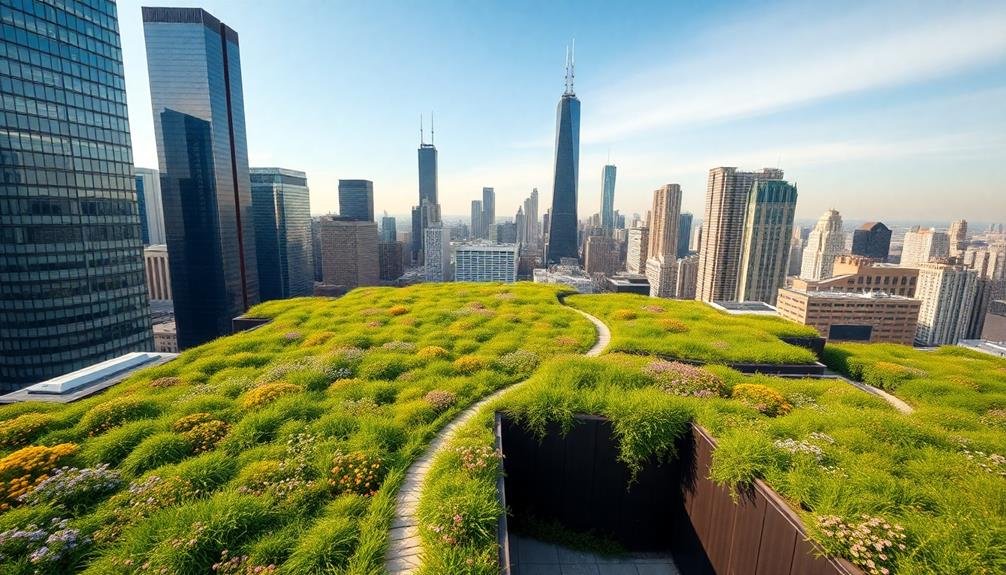
Chicago's skyline is getting greener, thanks to an innovative initiative that's transforming barren rooftops into vibrant meadows. You'll find these urban oases atop office buildings, schools, and residential complexes, creating a patchwork of nature amidst the concrete jungle.
The city's green roof program isn't just about aesthetics. It's a multifaceted approach to tackle urban challenges. These rooftop meadows act as natural insulators, reducing energy costs for heating and cooling. They also absorb rainwater, easing the burden on the city's stormwater system and reducing flood risks.
You'll discover a rich biodiversity in these elevated gardens. Native prairie grasses, wildflowers, and even vegetable plots thrive, attracting bees, butterflies, and birds. It's not uncommon to spot employees taking lunch breaks or yoga classes in these serene spaces.
Chicago's initiative has inspired other cities worldwide. You can now find similar projects sprouting up in New York, London, and Singapore. As urban populations grow, these rooftop meadows offer a clever solution to create green spaces without sacrificing valuable ground-level real estate.
Singapore's Supertree Grove Spectacle

You'll be awestruck by Singapore's Supertree Grove, where towering vertical gardens showcase an impressive array of plant life.
As night falls, you're treated to a mesmerizing light show that transforms these futuristic structures into a technicolor spectacle.
Beyond their visual appeal, the Supertrees serve a practical purpose, harnessing solar energy and collecting rainwater to support the park's operations.
Vertical Gardens and Biodiversity
Towering up to 16 stories high, Singapore's Supertree Grove stands as a tribute to innovative urban green space design. These vertical gardens aren't just eye-catching; they're living ecosystems teeming with biodiversity. You'll find over 162,900 plants from more than 200 species thriving on these man-made structures, creating a lush canopy in the heart of the city.
The Supertrees serve multiple purposes beyond their aesthetic appeal. They're equipped with environmental technologies that mimic the functions of natural trees. You'll see solar panels harnessing energy, rainwater collection systems, and air intake devices for the conservatories below.
Here's a breakdown of the Supertrees' key features:
| Feature | Function | Benefit |
|---|---|---|
| Vertical Planting | Hosts diverse plant life | Increases urban biodiversity |
| Solar Panels | Collects solar energy | Powers park operations |
| Rainwater Collection | Gathers and filters rainwater | Supports irrigation and fountain displays |
Futuristic Light Shows
As night falls, Singapore's Supertree Grove transforms into a dazzling spectacle of light and sound. You'll witness a futuristic light show that redefines urban park experiences. These towering structures, ranging from 25 to 50 meters tall, come alive with a symphony of colors and patterns.
The Supertrees' light show, known as "Garden Rhapsody," captivates visitors with its innovative design and cutting-edge technology. You'll be mesmerized by:
- Over 160,000 plants adorning the Supertrees, illuminated by dynamic lighting
- Synchronized music and light displays that change themes regularly
- Interactive elements allowing visitors to influence the light patterns
- Sustainable design incorporating solar panels to power the nightly shows
As you stroll through the grove, you'll feel transported to a sci-fi landscape. The Supertrees' canopies, connected by aerial walkways, offer breathtaking views of the illuminated gardens below.
This immersive experience showcases how modern technology can enhance nature in urban settings. The Supertree Grove's futuristic light show serves as a blueprint for innovative city park designs worldwide, demonstrating how public spaces can captivate and inspire through the seamless integration of nature and technology.
Sustainable Energy Production
Beyond the mesmerizing light show, Singapore's Supertree Grove serves as a model for sustainable energy production in urban parks. These towering structures harness solar energy through photovoltaic cells integrated into their canopies, powering the park's lighting and operations.
You'll find that the Supertrees aren't just for show; they're functional marvels of green technology. They collect rainwater for irrigation and act as air intake and exhaust functions for nearby conservatories. The trees also generate electricity through their solar cells, contributing to the park's energy needs.
Here's a breakdown of the Supertrees' sustainable features:
| Feature | Function |
|---|---|
| Solar Cells | Generate electricity |
| Rainwater Collection | Irrigation system |
| Air Circulation | Conservatory ventilation |
| Vertical Gardens | Host diverse plant species |
| LED Lighting | Energy-efficient illumination |
As you explore the grove, you'll notice how these features seamlessly blend into the overall design. The Supertrees demonstrate that urban parks can be both visually stunning and environmentally responsible. They're setting a new standard for sustainable energy production in public spaces, inspiring cities worldwide to reimagine their green areas as multifunctional ecosystems.
London's Serpentine Sky Bridge
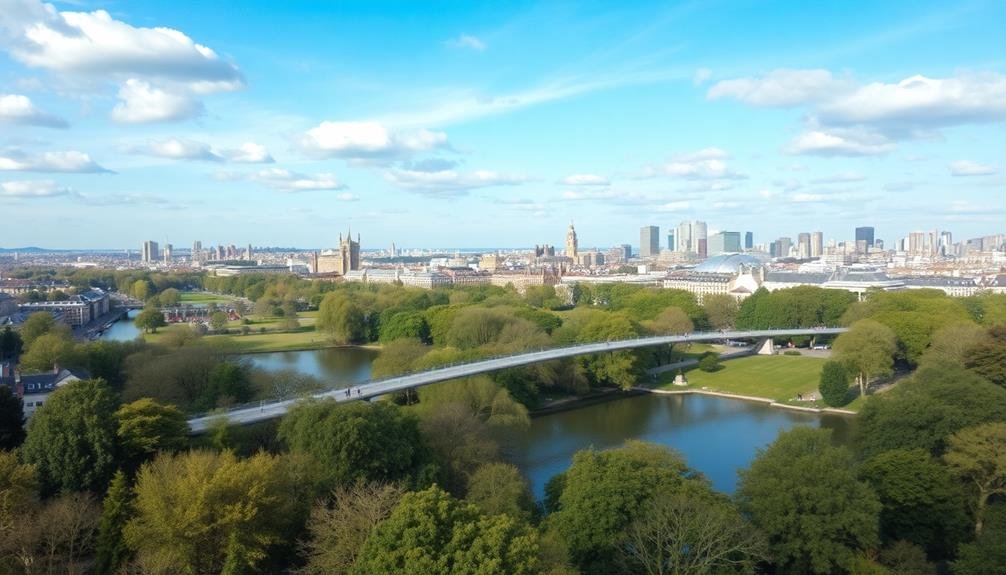
In the heart of London, the Serpentine Sky Bridge offers a unique aerial perspective of Hyde Park. This innovative structure spans the Serpentine Lake, providing visitors with breathtaking views of the surrounding landscape.
You'll find yourself suspended above the water, walking on a transparent pathway that seems to float in mid-air.
The Sky Bridge isn't just a feat of engineering; it's a demonstration of sustainable design. It's constructed using eco-friendly materials and incorporates:
- Solar panels that generate clean energy for lighting
- Rainwater collection systems for irrigation
- Wind turbines that power information displays
- Recycled materials in the bridge's structure
As you stroll across, you'll notice how the bridge seamlessly integrates with the park's natural environment.
It's designed to minimize impact on local wildlife while maximizing the visitor experience. Interactive displays along the way offer insights into the park's history and ecology.
The Serpentine Sky Bridge has quickly become a must-see attraction, drawing both locals and tourists alike.
It's not just a pathway; it's a destination in itself, offering a fresh perspective on one of London's most beloved green spaces.
Barcelona's Suspended Playground Network
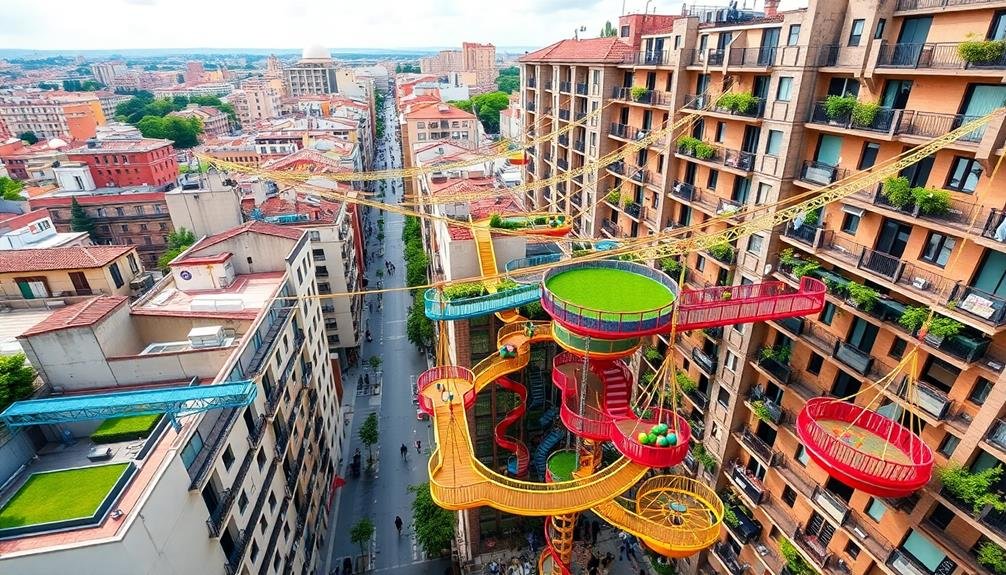
Innovation soars to new heights in Barcelona's Suspended Playground Network. You'll find this unique urban playground concept elevating children's play spaces above the bustling city streets. Suspended between buildings, these interconnected play areas offer a safe and exciting environment for kids to explore.
As you look up, you'll see a web of bridges, platforms, and climbing structures stretching across the cityscape. The network's design incorporates durable, lightweight materials that guarantee safety while minimizing the impact on existing architecture.
You'll notice how seamlessly it integrates with Barcelona's urban fabric, creating a harmonious blend of play and city life. The suspended playgrounds feature various interactive elements, including slides, swings, and obstacle courses.
You'll appreciate how they encourage physical activity and social interaction among children. The network also serves as a unique way to utilize unused urban airspace, transforming it into valuable recreational areas.
Barcelona's Suspended Playground Network isn't just about fun; it's an indication of innovative urban planning. You'll see how it addresses the challenge of limited ground space in densely populated areas while providing essential play areas for the city's youngest residents.
Tokyo's Urban Canopy Walkways
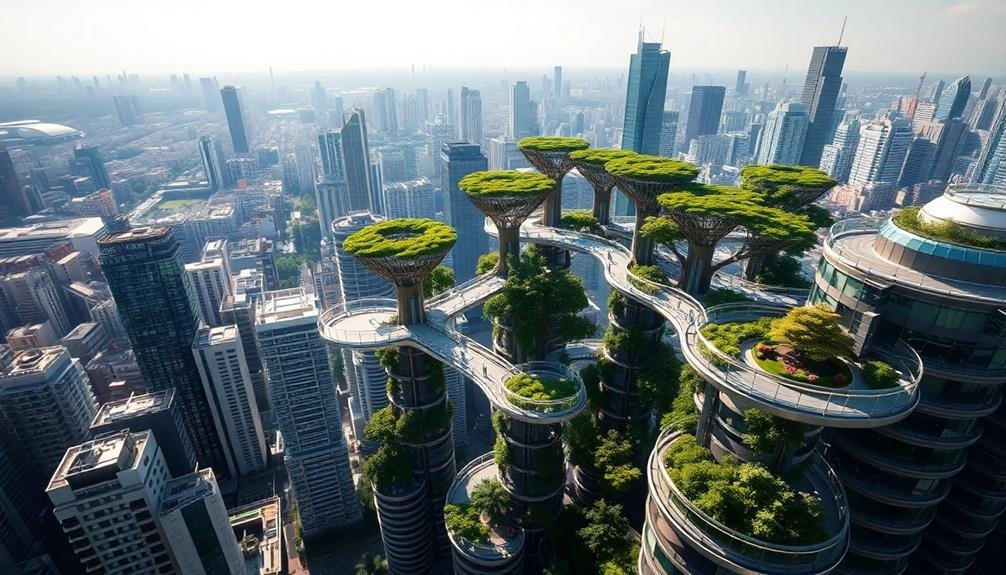
Tokyo's Urban Canopy Walkways take the concept of elevated urban spaces to new heights. You'll find yourself immersed in a network of suspended pathways that weave through the city's skyscrapers, offering a unique perspective on urban life.
These innovative structures blend nature with architecture, creating a harmonious balance between the bustling metropolis and tranquil green spaces.
As you explore Tokyo's Urban Canopy Walkways, you'll encounter:
- Lush greenery and vertical gardens integrated into the walkway design
- Observation decks providing panoramic views of the cityscape
- Interactive art installations that change with the seasons
- Climate-controlled sections for year-round comfort
You'll appreciate how these elevated pathways reduce pedestrian congestion at street level while offering a safer, more enjoyable way to navigate the city.
The walkways also serve as wildlife corridors, supporting urban biodiversity and creating a more sustainable urban environment.
Sydney's Harbor-Integrated Green Spaces

You'll find Sydney's harbor-integrated green spaces offer unique ways to experience the city's iconic waterfront.
Elevated harbor viewing platforms provide panoramic vistas of the bustling port and its surroundings.
Waterfront botanical gardens showcase native flora, while floating green islands create tranquil oases amidst the harbor's activity.
Elevated Harbor Viewing Platforms
Sydney's harbor-integrated green spaces boast several elevated viewing platforms that offer breathtaking panoramas of the iconic waterfront. You'll find these platforms strategically placed throughout the city, providing unique vantage points to appreciate the harbor's beauty and bustling activity.
As you explore these elevated havens, you'll encounter:
- Sleek, modern structures with floor-to-ceiling glass panels
- Cantilevered decks that seem to float above the water
- Multilevel observation towers with 360-degree views
- Green rooftops doubling as viewing areas and urban gardens
These platforms aren't just about the views; they're designed to enhance your overall experience. You'll notice informative plaques detailing the harbor's history and ecology, as well as high-powered telescopes for a closer look at distant landmarks.
Don't be surprised to find these spaces buzzing with activity. They've become popular spots for locals and tourists alike, hosting everything from yoga classes to outdoor art exhibitions.
As the sun sets, you'll witness the harbor transform into a dazzling display of lights, making these elevated platforms the perfect perch for evening relaxation or nighttime photography.
Waterfront Botanical Gardens
While the elevated platforms offer stunning views from above, the waterfront botanical gardens allow you to immerse yourself in nature at sea level. Sydney's harbor-integrated green spaces blend urban design with coastal ecology, creating a seamless connection between city and sea. You'll find native Australian plants alongside exotic species, all thriving in carefully curated environments that mimic natural ecosystems.
As you stroll through these gardens, you'll encounter educational displays about marine life and coastal habitats. Interactive features let you engage with the environment, from touch pools to augmented reality installations that reveal underwater worlds.
Here's a breakdown of what you'll experience in these innovative spaces:
| Feature | Description |
|---|---|
| Coastal Plants | Salt-tolerant species |
| Marine Life | Tidal pools and aquariums |
| Eco-Education | Interactive exhibits |
| Water Features | Sustainable irrigation systems |
| Art Installations | Nature-inspired sculptures |
These waterfront botanical gardens serve multiple purposes: they're not just beautiful spaces for relaxation and recreation, but also act as living laboratories for climate change research and biodiversity conservation. You'll see firsthand how cities can adapt to rising sea levels while preserving natural habitats and enhancing urban green space.
Floating Green Islands
Several floating green islands dot Sydney's harbor, offering a unique blend of nature and engineering. These innovative structures provide a rejuvenating escape from the bustling city while enhancing the harbor's ecosystem.
You'll find these man-made oases seamlessly integrated into the urban waterfront, creating a harmonious balance between the built environment and nature.
As you explore these floating green spaces, you'll discover:
- Native plant species that thrive in the unique marine environment
- Seating areas and walkways made from sustainable materials
- Solar-powered lighting systems for evening enjoyment
- Underwater habitats that support marine life diversity
These floating islands serve multiple purposes beyond their aesthetic appeal. They help filter pollutants from the water, reduce wave action, and provide habitats for local wildlife.
You'll notice how they change with the tides, rising and falling while remaining securely anchored.
The design of these islands incorporates cutting-edge technology to guarantee their longevity and minimal environmental impact.
You'll appreciate how they've been engineered to withstand harsh weather conditions while requiring minimal maintenance.
As you stroll along the harbor, you'll see firsthand how these floating green islands have transformed Sydney's waterfront into a more sustainable and inviting urban space.
Dubai's Desert Bloom Skyscrapers
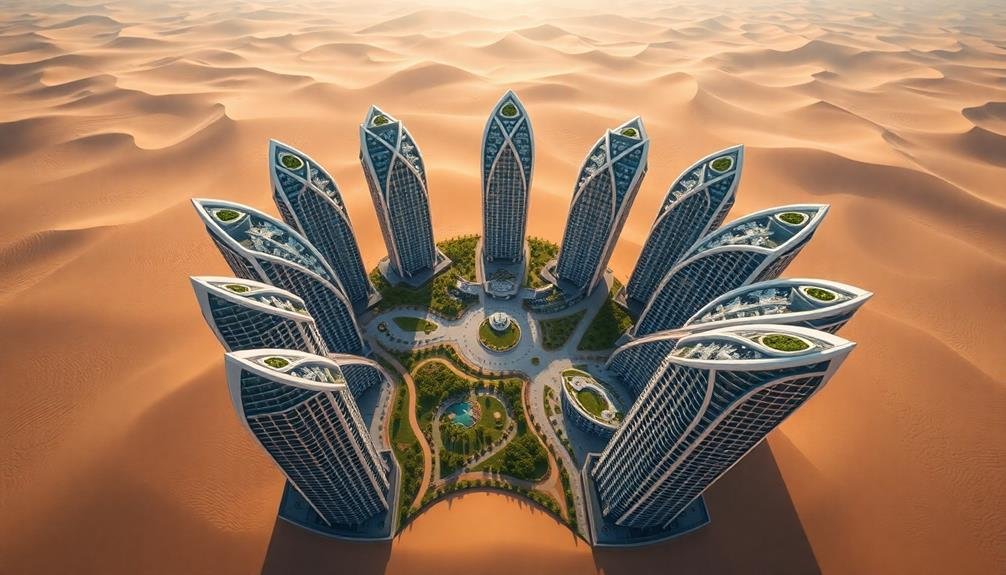
Although Dubai is known for its extravagant architecture, the Desert Bloom Skyscrapers take urban greenery to new heights. These innovative structures blend the city's futuristic skyline with nature, creating vertical gardens that defy the harsh desert climate.
You'll find these skyscrapers covered in a network of interconnected pods, each housing diverse plant species. The pods are designed to capture and recycle water, making the most of Dubai's limited resources. They're equipped with smart irrigation systems and climate-controlled environments, ensuring the plants thrive year-round.
As you walk through Dubai, you'll notice how these green towers improve air quality and reduce the urban heat island effect. They provide habitats for birds and insects, boosting biodiversity in an otherwise arid landscape. The buildings' exterior acts as a living skin, changing colors with the seasons and creating a dynamic visual spectacle.
Inside, you'll experience lush interior gardens and sky bridges connecting different levels. These green spaces offer residents and visitors a chance to reconnect with nature, even in the heart of this bustling metropolis.
Dubai's Desert Bloom Skyscrapers exemplify how cities can integrate nature into their vertical expansion, creating sustainable urban ecosystems.
Copenhagen's Bicycle Superhighway Parks

Copenhagen has taken urban cycling to the next level with its innovative Bicycle Superhighway Parks. You'll find these elevated green spaces seamlessly integrated into the city's extensive cycling network, offering a unique blend of transportation and recreation.
As you pedal through these parks, you're not just commuting; you're experiencing a new dimension of urban design.
These superhighway parks feature:
- Elevated cycling paths that provide uninterrupted routes across the city
- Lush greenery and native plantings that improve air quality and biodiversity
- Rest areas with bike repair stations and water fountains
- Solar-powered lighting for safe nighttime cycling
You'll appreciate how these parks transform unused spaces above busy streets into thriving ecosystems.
They're designed to reduce congestion, promote physical activity, and create a more sustainable urban environment.
As you ride, you'll notice how the parks connect key destinations, making your commute faster and more enjoyable.
Copenhagen's Bicycle Superhighway Parks aren't just about getting from point A to B; they're about reimagining how you interact with your city, turning everyday travel into an opportunity for urban exploration and environmental stewardship.
Frequently Asked Questions
How Do These Elevated Parks Impact Local Wildlife and Bird Migration Patterns?
You'll find that elevated parks can provide new habitats for urban wildlife. They're often beneficial for birds, offering resting spots during migration. However, they might disrupt some local species' patterns, so careful planning is essential.
What Safety Measures Are in Place for Extreme Weather Events?
You'll find robust safety systems in these elevated parks. They've got sturdy wind barriers, lightning rods, and emergency evacuation routes. You're protected by weatherproof shelters and real-time weather monitoring. Don't worry, they've thought of everything for your safety.
How Do These Designs Address Accessibility for People With Mobility Challenges?
You'll find these designs prioritize accessibility. They've incorporated ramps, wider pathways, and level surfaces throughout. You'll also notice strategically placed rest areas, handrails, and tactile guidance systems to guarantee everyone can enjoy the park comfortably.
What Maintenance Challenges Arise From Such Unique Elevated Green Spaces?
You'll face unique maintenance challenges with elevated green spaces. You're dealing with irrigation issues, wind exposure, and weight constraints. You'll need specialized equipment for repairs and gardening. Don't forget about safety concerns for workers at height.
How Do These Parks Affect Property Values and Gentrification in Surrounding Neighborhoods?
You'll notice these parks boost property values considerably. They're attractive amenities that draw in affluent residents. Unfortunately, this often leads to gentrification, pushing out long-time locals who can't afford rising rents and property taxes in the area.
In Summary
You've seen how urban planners are revolutionizing city parks with sky-high designs. From floating gardens to vertical forests, these innovative spaces bring nature to unexpected places. They're not just pretty – they're improving air quality, reducing urban heat, and creating new habitats. As cities grow denser, look up to find green oases. The future of urban parks is soaring to new heights, transforming cityscapes and enhancing your quality of life in exciting ways.

As educators and advocates for responsible drone use, we’re committed to sharing our knowledge and expertise with aspiring aerial photographers.
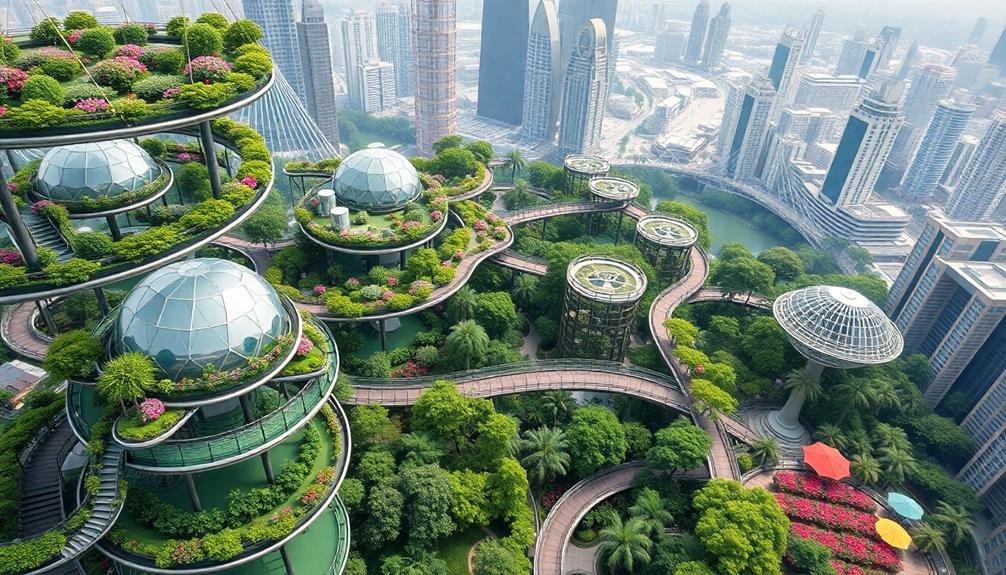



Leave a Reply